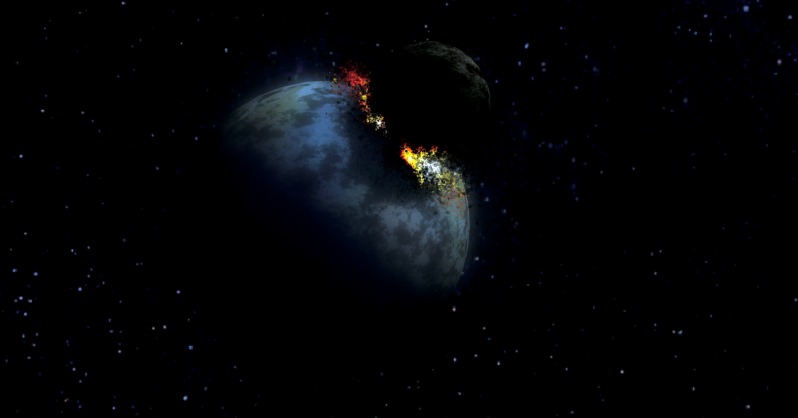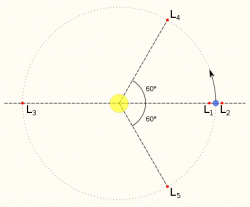

Did the asteroid that hit the Earth, creating the Moon, originate from one of Earth's Lagrangian points? (ESA)
[/caption]
Two solar telescopes launched to study coronal mass ejections and the solar wind have been sent to do an entirely different task. Currently, the Solar Terrestrial Relations Observatory (STEREO) probes are flying in opposite directions; one directly in front of Earth’s orbit and the other directly behind. This unique observatory is intended to view the solar-terrestrial environment in unprecedented detail, allowing us to see the Sun from two vantage points.
This might sound like an exciting mission; after all, how many space-based observatories have such a unique perspective on the Solar System from 1 AU? However, both STEREO probes are currently moving further away from the Earth (in opposite directions), approaching a gravitational no-man’s land. STEREO is about to enter the Earth-Sun Lagrangian points L4 and L5 to hunt for some sinister lumps of rock…


The L2 point is located at approximately the same distance, but on the opposite side of the Earth. In this case, the Earth is constantly eclipsing the Sun. The L3 point is on the opposite side of the Sun from the Earth, at approximately 1AU. Now this is where it starts to get a little strange. The L4 and L5 points are located 60° in front and 60° behind the Earth’s orbit. The 4th and 5th Lagrangian points are also the most gravitationally stable regions, primordial debris lurks, trapped in the Lagrangian prisons. Although the L1 point is often considered to be the most stable of the Lagrangian points (as it’s directly locked between the gravity of the Sun and Earth), even space observatories (such as SOHO and ACE) have to carry out complex orbits to remain in place. Otherwise the delicate balance will be lost and they will drop away from L1.
L4 and L5 are in fact the most stable locations, balanced by a complex cage of competing gravitational components from the Earth and the Sun. It is thought that these two regions have trapped lumps of rock and dust all the way through the evolution of the Solar System, making them a very interesting place to send a space mission. And the two solar probes of STEREO are currently racing toward L4 and L5, about to explore the gravitational dead zone, whether they like it or not.
It is a known fact that other planets in the Solar System possess these islands of gravitational calm, and asteroids have been observed sitting in stable locations in front and behind of Jupiter’s orbit for example (called “Trojans” and “Greeks”). Does Earth have a swarm of asteroids sitting in its L4 and L5 points? Scientists believe this is a certainty. However, no asteroids have ever been observed.
Although millions of kilometres across, L4 and L5 can only be observed at dawn and dusk. Any possibility of spotting a large asteroid diminishes rapidly as they are obscured by the Sun. So, the STEREO space telescopes are going to take the dive into L4 and L5 to see, first hand, what lies in wait.
Although STEREO wasn’t designed for this work, the mission already has a team of volunteer near-Earth asteroid hunters at the ready and their optics are more than capable of looking out for large lumps of rock invisible from Earth.
“The close-up investigation of L4 and L5 is completely new. That makes it something we should be driving,” says Richard Harrison of the Rutherford Appleton Laboratory in Oxfordshire, UK and a member of the STEREO project. “Wouldn’t it be spectacular if we actually backed past an asteroid? Saw it come creeping into view around the camera.” Now that would be a huge discovery.
This isn’t simply out of academic curiosity however. The Earth’s Moon is thought to have been formed after a huge cosmic impact with a small planetary body. The problem comes when trying to explain where the offending planetary body could have come from; too far away and it will have had too much energy. Rather than punching into the side of the Earth it would have shattered our planet. So the body must have formed a lot closer to our planet.
Did this body evolve in either the L4 and L5 points? If it did, and then somehow got kicked out of the gravitational island, perhaps careering toward the Earth, causing the cataclysmic impact that seeded the formation of the Moon.
It is exciting to think that STEREO may make some ground-breaking discoveries not Sun related. I just hope they don’t bump in to any chunks of rock, it could be pretty crowded out there…
Source: New Scientist
It’s not unusual for space probes to complete gravitational flyby manoeuvres en route to their…
According to the most widely held astronomical model (the Nebular Hypothesis), new stars are born…
The hunt for aliens goes hand in hand with the hunt for habitable planets. Astronomers…
Computers are an integral part of space exploration, keeping them functioning when away from Earth.…
By the end of this decade, NASA, the Chinese National Space Agency (CNSA), Roscosmos, and…
Could a new, fifth force of nature provide some answers to our biggest questions about…